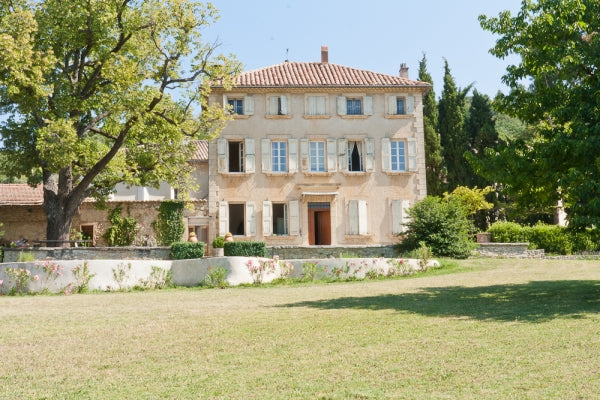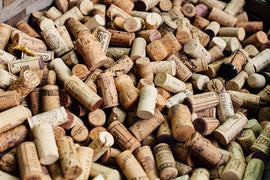The variety of grapes grown throughout the world is unbelievable, and the number of wines produced—too many to count. Our wine club gives us an opportunity to explore both the less familiar and the recognizable. In the past year we’ve traversed the globe sampling wines from Lebanon, Germany, Italy, the far reaches of Spain and France, some exciting wines from the New World, and more. Wines are chosen to reflect personalities of the grape, the soil, the winemaking, and the people. It’s always amazing what can be revealed as a wine travels from your nose, to your tongue, and to your mind. The New Year promises to hold lots of surprises and treasures as we continue our exploration. Fasten those organoleptic seatbelts, it’s going to be a fun ride! From all of us at PlumpJack, drink well, eat well, and Happy Holidays!
Principauté d'Orange IGP, Vaucluse, France
Beneath the steep slopes of the jagged Dentelles de Montmirail in the Southern Rhône, lies a band of some of the most beautiful wine villages in France: Sablet, Cairanne, Séguret, Rasteau, Gigondas, Vacqueyras and Beaumes-de-Venise. Set off by a backdrop of garrigue (windswept hilltops and slopes inhabited by scrub-brush and Provençal herb outcroppings), and soft, tree-clad hillsides, their vineyards cover the plains and intermediate slopes and spread high into the hills. The vineyards of Gigondas are some of the most ancient in the area. Since Roman times, olive trees and fruit trees were always planted beside the vines, but in 1929 and 1956, a devastating spring freeze destroyed nearly all the fruit trees, leaving just the vines, and forcing the producers to concentrate only on their wines. Gigondas was granted full Appellation Contrôlée status in 1971. It was one of the first Southern Rhône villages to earn its own appellation. Château de Saint Cosme lies in the heart of Gigondas, where 15 hectares of vineyard grow in the shade of the Dentelles de Montmirail. Château de Saint Cosme claims the title of “most ancient estate of the region” and the estate’s beginnings can be traced to 1416, but goes back even further—almost 300 additional years—to when the Saint Cosme chapel was being built. Add another millennium to that, which places us around the year 109 (!) and you’ll find a Roman villa with 25 wine vats carved directly into the rocky earth—they are still perfectly preserved in the cellars of Saint Cosme. Louis Barruol took over from his father in 1992, making a dramatic shift to quality and converting to biodynamics in 2010. He represents the fifteenth generation of winemakers in his family. Among the changes Louis has made are new plantings of 25 acres of vineyards located near Violès. The Saint Martin Vineyard in Violès is located right on the boundary with the Gigondas appellation, across the river Ouvèze, which marks the border between the two villages. The two villages share historical bonds: Gigondas and Violès have always been part of the Principality of Orange, annexed to France during the French Revolution. Louis says, “During my various travels and tastings in the Rhône Valley, I often thought that many great terroirs were under-exploited. I really liked some locations and I wanted to try.” St. Cosme’s new plantings include Bourboulenc, Marsanne, Viognier, Picpoul, Clairette, and Ugni Blanc. The first usuable harvest from these vineyards went into their estate bottling of the 2016 “Les Deux Albion Blanc”.
Domaine de Saint Cosme “Les Deux Albions Blanc” carries the Principauté d'Orange IGP classification. Louis disregards the lowly Vin de Pays de la Principauté d'Orange designation the wines from this region are classified under. "The level of limestone here is, I think, the highest in the region," he says. "I think it has some excellent potential." The 2017 “Les Deux Albion” is only the Estate’s second vintage and it is a blend of 50% Viognier, 30% Picpoul, and 20% Marsanne. Once fermentation is complete, the wine is aged on the lees in a combination of 500 liters and 228 liters one-year-old French oak barrels, and stainless-steel tanks for 5 months before bottling. The end result is a wine that is full-bodied and round in the mouth overflowing with yellow apple, apricot, melon and star fruit flavors.The Masanne and Viognier, aged in neutral barrels, provide a full body and rich texture with just-medium acidity, while Picpoul brings acidity to the blend and gives this wine salinity. The 2017 “Les Deux Albion Blanc” is perfect to enjoy on its own but also excellent with spicy and creamy dishes with firm fish and white meats, especially poultry. Try it with mushroom risotto, cannelloni with ricotta, crab cakes, escargots, Greek spanakopita, hummus, poultry/vegetable pâtés, potato salad, scallops, and spinach soufflé.
The 2017 Domaine de Saint Cosme “Les Deux Albions Blanc” is $20.00/bottle, $216.00/case.
Brézème, France
The Rhône River begins life way to the north in Switzerland. As it makes it way down through the length of France, it widens to become the central feature of the Rhône valley, which spans roughly between Lyons and Avignon. The Rhône valley divides neatly into north/south regions at the town of Valence. The Northern and Southern Rhône regions’ climate, topography and soil types are quite distinct. In the ‘mediterranean’ South (mild winters, hot summers), the rolling terrain is marked by sandy soils and plots thick with galet stones. In the ‘continental’ North (cold winters, warm summers), the steep, steep slopes have been carved into granite hillsides by the progress of the river over thousands of years. Vines cling to near vertical surfaces, or terraces carved into the rock. Along with those in Germany's Mosel Valley, the vineyards here are amongst the steepest and most difficult to work in the world. The Northern Rhône accounts for only 5% of the total wine production of the Rhône Valley. The most definitive difference between the South and North is that of varietal. Although white wines from both regions can use Viognier, Marsanne and Roussanne grapes (depending on the appellation), the Southern Rhône specializes in Grenache (usually blending it with minority portions of Syrah, Mourvèdre, and Cinsault), while the Northern Rhône is pure Syrah country. For lovers of Syrah, the Northern Rhône wines are the standard-bearers famed for their high quality, and for the dramatic change in character that takes place from youth to maturity. When the red wines are young they are tannic and intensely spicy, with aggressive tar and fresh ground pepper flavors and aromas. As they age, the wines develop depth and richness and display the underlying blackberry, currant and smokey notes. The eight AOCs that make up the Northern Rhône – Cote Rotie, Condrieu, Chateau Grillet, St. Joseph, Crozes-Hermitage, Hermitage, Cornas and St. Péray (from north to south) – run along a 45-mile stretch of the Rhône River from Vienne to Valence, with most of the vineyards planted on the river’s stunningly steep western banks. Surrounding the hills of Hermitage is the largest appellation of Northern Rhône, Crozes-Hermitage, covering almost 3,700 acres. The appellation is composed of three geologic terrains, each yielding a differing style of wine. The best and most structured wines come from vines overlying the narrow exposure of granite. Other soils contain glacial alluvium, pebbles and stones deposited in the area by glaciers.
In 1981, with only one hectare of land (2.5 acres), Jean-Marie and Sylvette Lombard created the Domaine Lombard estate. The Lombards were among the first to initiate the revival of the Brézème terroir in the Northern Rhône after it was decimated by the Phylloxera outbreak, falling from 250 acres to just a few acres in the 1930s. They encouraged other growers to plant here and set about expanding the estate over the next two decades, raising the profile of the region. In 2012, winemakers Emmanuelle and Julien Montagnon took over the estate and replanted part of the vineyards. Originally from the Livron area, Julien and Emmanuelle brought new vision to the estate and introduced more natural grape growing and winemaking practices. The estate is now double certified in organic farming and biodynamic agriculture. Today, Domaine Lombard covers 16 hectares (39 acres and is the only estate in the region to have planted grapes in all five named vineyards (lieux-dits) in Brézème. While the “Domaine Lombard” wines are all grown, bottled, and aged on the estate in Brézème, the “Maison Lombard” wines are their “négociant” wines, made with grapes purchased from the best growers in other prestigious Northern Rhône regions such as Crozes-Hermitage, Hermitage and Cornas.
Maison Lombard’s 2014 Crozes Hermitage is made exclusively with grapes from the “Chassis” terroir. The area, one of the best growing areas of the appellation, is located to the south and east of Tain-l’Hermitage and is composed of thick layers of pebbles from different glacial periods, mixed with red clay to form relatively flat landscapes known as “Chassis” (plateaus or terraces). Maison Lombard’s Crozes Hermitage is vinified with low intervention, natural yeast, and light filtration. The fermentation is partly done with whole clusters in stainless-steel vats, with regular pump-overs. The wine is then aged in concrete tanks for 10-12 months.
The Maison Lombard Crozes Hermitage is vibrant and bright capturing the essence of the grape from this soil type. Delicately floral on the nose, the taste offers up initial savory earthy notes with fresh acidity, a touch of pepper, and subtle cherry and blueberry fruit. It has fine youthful tannins and well-integrated oak with perhaps a hint of mint on the lingering juicy finish. Try it with braised beef cheeks, grilled steak or sausages, roasted pork or squab, mushroom soup or roasted root vegetables with polenta and Gorgonzola.
The 2014 Maison Lombard Crozes Hermitage is $27.00/bottle, $291.60/case.
Image via Chateau de Saint Cosme





